Assessing Hibiscus rosa-sinensis Linn as an Excipient in Sustained-Release Tablets
Natural gums and mucilage are biocompatible, cheap, readily available, and represent a potential source of excipients. The authors examine the functionality of mucilage extracted from the leaves of Hibiscus rosa-sinensis Linn as an excipient in a sustained-release tablet formulation.
Making drug-embedded matrix tablets through the direct compression of a blend of drug, retardant material, and additives is one of the simplest formulation approaches. The inclusion of polymeric materials in a matrix system is a common method of modulating drug release (1). Drug-release retarding polymers are the key performers in matrix systems. Various polymers have been investigated as drug-retarding agents, each presenting a different approach to the matrix system. Based on the features of the retarding polymer, matrix systems are usually classified into three main groups: hydrophilic, hydrophobic, and plastic. Hydrophilic polymers are most suitable for retarding drug release, and interest is growing in using these polymers in sustained drug delivery (2–4).
In India, natural gums and mucilage are well known for their medicinal use. Natural gums and mucilage are preferred to semisynthetic and synthetic excipients because of their lack of toxicity, low cost, availability, soothing action, and nonirritant nature (5–8). Many natural materials are studied for use in sustained-release tablets. These materials include: guar gum (9), ispaghula husk (10), olibanum and its resins (11), cross-linked high amylose starch (12), Ulmus fulva (slippery elm mucilage) (13), pectin (14), Peumus boldus dry plant extract (15), galactomannon from Mimosa scabrella (16, 17), Gleditsia triacanthos Linn (honey locust gum) (18), Sesbania gum (19), mucilage from the pods of Hibiscus esculenta (20), Tamarind seed gums (21), and gum copal and dammar (22).
Hibiscus rosa-sinensis Linn has not been explored as a pharmaceutical excipient. Hibiscus rosa-sinensis Linn of the Malvaceae family is also known as the shoe-flower plant, China rose, and Chinese hibiscus. The plant is available in India in large quantities, and the leaves contain mucilage (23, 24). The leaves are used in traditional medicines as emollients and aperients to treat burning sensations, skin disease, and constipation (25). The plant contains cyclopropanoids, methyl sterculate, methyl-2-hydroxysterculate, 2-hydroxysterculate malvate, and β-rosasterol. Mucilage of Hibiscus rosa-sinensis contains L-rhamnose, D-galactose, D-galactouronic acid, and D-glucuronic acid (26). The leaves contain carotene (7.34 mg/100 g of fresh material) and are used as cattle feed (27). The leaves also contain moisture, protein, fat, carbohydrate, fibers, calcium, and phosphorus (28).
The objective of this study was to extract mucilage from the leaves of Hibiscus rosa-sinensis Linn and examine the various pharmaceutical properties of the dried mucilage to assess its functionality as an excipient. Specifically, the study evaluated the physicochemical properties and examined the effect of polymer blends on the rate and kinetics of diclofenac sodium released from matrix tablets.
Diclofenac sodium is a potent nonsteroidal anti-inflammatory drug. Diclofenac sodium rapidly dissolves in intestinal fluid, reaches its maximum blood concentration (Cmax) within 30 min, and is metabolized mainly by hepatic hydroxylation and subsequent conjugation (29). In healthy human volunteers, the mean plasma clearance of diclofenac sodium was 16.0 L/h, and the mean elimination half-life of the terminal phase was 1.2–1.8 h (30). To reduce gastrointestinal irritation, a common problem with all nonsteroidal anti-inflammatory agents, effective enteric-coated dosage forms have been developed. Food delays the absorption of the drug, which causes a nonreproducible pharmacokinetic profile, and the drug has no immediate therapeutic effect (31).
Drug release from hydrophilic matrices is a complex interaction between dissolution, diffusion, and the erosion mechanism. In this study, the drug-release mechanism was evaluated for diclofenac sodium tablets prepared with highly hydrophilic mucilage from the leaves of Hibiscus rosasinensis Linn. A 32 full factorial design was carried out to evaluate the effect of certain variables such as the amount of mucilage and diluent. Further studies were performed using water uptake, the mass loss of pure mucilage, and the matrix tablet containing the drug and mucilage. A stability study for an optimized batch was performed for three months.
Experimental design
Materials. Diclofenac sodium was received as a gift from Beacon Pharmaceuticals (Ahmedabad, India). The leaves of Hibiscus rosa-sinensis Linn were collected from the medicinal garden of the C.K. Pithawala Institute of Pharmaceutical Science and Research in Surat, India. Guar gum Indian Pharmacopoeia (IP) grade, ispaghula husk, sodium carboxymethyl cellulose IP, lactose IP, talc IP, and magnesium stearate IP were received from Atul Chemicals (Anand, India). All other solvents and chemicals were of analytical-reagent grade. Deionized double distilled water was used throughout the study.
Methods. The fresh leaves of Hibiscus rosa-sinensis Linn were collected, washed with water to remove dirt and debris, and dried. The powdered leaves were soaked in water for 5–6 h, boiled for 30 min, and kept aside for 1 h for complete release of the mucilage into water. The material was squeezed from an eight-fold muslin cloth bag to remove the marc from the solution. Acetone was added to the filtrate to precipitate the mucilage in a quantity of three times the volume of the total filtrate. The mucilage was separated, dried in an oven at a temperature < 50 °C, collected, dried-powdered, passed through a sieve (number 80), and stored for further use in desiccators (32).
Physicochemical properties of dried powdered mucilage. Dried- powdered mucilage was studied for percentage yield, particle size, mass loss on drying, viscosity, swelling index, bulk density, angle of repose, and compressibility.
Particle size. The microscopic method was used (in triplicate) to determine the particle size of the dried mucilage.
Mass loss on drying. The mass loss on drying was determined for an appropriate quantity of dried mucilage at 105 °C for 2 h in a hot-air oven.
Swelling ratio. The study was carried out in a 100-mL stoppered graduated cylinder. The initial bulk volume of 1 g of dried mucilage was measured, and water was added in sufficient quantity to yield a 100-mL uniform dispersion. The sediment volume of the swollen mass was noted after 24 h in storage at room temperature. The swelling ratio was calculated by determining the ratio of the swollen volume to the initial bulk volume. The swelling ratio was evaluated in distilled water, simulated gastric fluid (0.1 N HCl), and phosphate buffer (pH 6.8) (33).
Viscosity. Rheological studies of dried mucilage were carried out using various concentrations of solution (0.1–0.5% weight/volume (w/v) in distilled water. The viscosity was measured using an Ostwald viscometer and compared with the viscosity of sodium carboxymethylcellulose.
Bulk and tapped density. A preweighed and presieved quantity of dried mucilage was poured into a graduated cylinder, and the volume recorded. The cylinder was tapped until the powder bed volume reached a minimum value, and the tapped volume was recorded. The bulk and tapped densities were calculated. Carr's index and Hausner ratio. Carr's index and Hausner ratio were calculated from the bulk and tapped densities.
Angle of repose. The angle of repose (θ) was determined using the fixed-height funnel method and calculated as follows:

in which h is the height of the powder heap and r is the radius of the powder heap. Comparisons were made between dried mucilage, guar gum, and ispaghula husk.
Preparation of diclofenac sodium tablets. The required quantities of diclofenac sodium and dried mucilage powder (sieve number 80) were physically admixed. Lactose was included in the nine batches of factorial design. The powder blend was lubricated with 1% w/w talc and 2% w/w magnesium stearate. Lubrication was performed in a glass jar for 2 min. Each tablet contained 100 mg of the drug. The tablets were prepared by direct compression on a rotary tablet press (Rimek II, Karnavati Engineering, Ahmedabad, India) and fitted with concave punches of 9 mm in diameter. The turret was rotated at a fixed speed of 30 rpm (34).
Hardness and friability test. Hardness was determined by using the Monsanto hardness tester, and friability was evaluated as the percentage weight loss of 20 tablets tumbled in a friabilator (Model EF2, Electrolab, Mumbai, India) for 4 min at 25 rpm. The tablets were dedusted, and the loss in weight caused by the fracture or abrasion was recorded as the percentage friability.
Uniformity of weight. The weight-variation test was performed. Twenty tablets were weighed individually, and the average weight was calculated.
Dissolution-rate study. The drug-release study was carried out using an USP XXIII paddle apparatus at 37 ± 0.50 °C at 50 rpm using 900 mL of distilled water and phosphate buffer (pH 6.8) as the dissolution medium (n = 5). A 5-mL sample solution was withdrawn at predetermined time intervals, filtered through a 0.45-μm membrane filter, diluted suitably, and analyzed spectrophotometrically at 276 nm using a UV-visible double-beam spectrophotometer (Shimazdu-UV 1700, Shimazdu, Kyoto, Japan). Equal amounts of fresh dissolution medium were replaced immediately after withdrawing a test sample. The percentage of drug that dissolved at different time intervals was calculated using a regression equation generated from the standard curve. Drug release from the optimized batch (HL6) and a market preparation of the drug were studied in distilled water.
Full factorial design. A 32 randomized full factorial design was used. Two factors were evaluated, each at three levels, and experimental trials were performed at nine possible combinations. The ratio of mucilage (X1) and amount of lactose (X2) were selected as independent variables. The time required for 80% drug dissolution (t80) and percentage drug released in 60 min (Y60) and 300 min (Y300) were selected as dependent variables.
Hydration capacities and erosion studies. Erosion and water uptake of the formulated tablets were determined under conditions identical to those previously described for dissolution testing. Water uptake and mass loss were determined gravimetrically according to the following equations (35):
Percent water uptake =
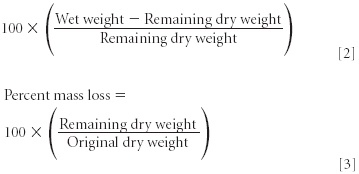
Three tablets were used per time point. At predetermined times, the ring-mesh assemblies supporting the partially hydrated tablets were carefully removed, and the tablets were lightly blotted with tissue paper to remove excess surface water. After determining the wet weight, the tablets were dried at 70 °C for one day before reweighing to determine the remaining dry weight. The test was performed at speeds of 50 and 100 rpm. Placebo tablets consisting of pure mucilage were tested in the same way. All studies were performed in triplicate.
Radial and axial swelling of the tablet. The initial diameter and thickness of the tablet were measured, and the tablet was kept in dissolution media. The increase in diameter and thickness was measured at various time intervals. To evaluate the relation, the equilibrium degree of swelling (Q) was calculated from the radial and axial swelling ratio using the following equation:

in which Vtand Vo are volumes; Rt and Ro are radius at time t and zero, respectively; and It and Io are thickness at time t and zero, respectively (36).
Stability study. To study the effect of storage on an in vitro drug release, the stability study of the best formulation (HL6) was carried out at 40 °C and 75% relative humidity in a humidity oven. Samples were withdrawn after a three-month interval, and in vitro drug release was performed.
Results and discussion
Various physiochemical characteristics of the extracted mucilage from Hibiscus rosa-sinensis Linn were investigated. The percentage yield was 15%, and the average particle size was 180 μm. The mass loss on drying indicated the amount of moisture present in the material that was available to interact with other material. For dried mucilage, the mass loss on drying was 10.61%. The swelling ratio of mucilage was 9 in distilled water, 10 in simulated gastric fluid (0.1 N HCl), and 9 in phosphate buffer (pH 6.8). The authors concluded that the swelling of mucilage is pH-independent, and the mucilage is nonionic.
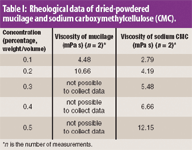
Table I: Rheological data of dried-powdered mucilage and sodium carboxymethylcellulose (CMC).
The viscosity of the extracted dried mucilage was compared with that of semisynthetic polymer sodium carboxymethyl cellulose (see Table I). When dried mucilage concentration exceeded 0.2% w/v, the viscosity was very difficult to measure with the Ostwald viscometer. The dried mucilage had higher viscosity than the sodium carboxymethylcellulose.

Table II: Flow properties of dried-powdered mucilage and other gums.
The flow properties and compressibility of the dried mucilage, including bulk and tapped density, Carr's index, Hausner ratio, and the angle of repose were assessed and compared with those of guar gum and ispaghula husk (see Table II). The angle of repose of a powder provides an insight into the magnitude of the cohesiveness of the powder and hence, its flowability. Mildly cohesive powders have angles of repose between 40° and 60° when measured by standard methods. Dried mucilage has an angle of repose of 27.83°. Guar gum and ispaghula husk have an angle of repose of 42.27°and 38.79°, respectively. From these results, the authors infer that the dried mucilage powder was less cohesive and had superior flow property. The Hausner ratio previews the degree of densification that could occur during tableting: the higher the ratio, the greater the propensity of the powder to densify. This phenomenon may produce tablets that lack uniformity of weight and content. The dried mucilage has excellent flow properties compared with those of guar gum and ispaghula husk. Dried mucilage, therefore, has flow properties suitable for use in a direct-compression formulation.

Table III: Formulation of tablets and Y60, Y300, and t80 of preliminary batches.
The average crushing strength of the prepared tablets was 4.8 kg/cm2 , a value which shows good strength. The friability was < 1% (i.e., between 0.75 and 0.91%). Tablets prepared from dried-powdered mucilage that passed the standard for uniformity in weight indicate homogenous drug content. These results show that tablets prepared from dried-powdered mucilage can be used as a directly compressible vehicle because of good hardness, low friability, and tablet-weight uniformity.

Table IV: Formulation and dissolution characteristics of batches in a 32 full factorial design.
Table III shows the composition of the preliminary batches (L1 to L3) and the results of their dissolution studies. Table IV shows the composition of the nine batches of the factorial design and the results of their dissolution studies. When the dissolution study of the preliminary batches was performed, the complete drug release was obtained within 9, 10, and 11 h with different proportions of mucilage and 100 mg of diclofenac sodium (see Table III). The authors concluded that mucilage is suitable as a sustained-release matrixing agent for a diclofenac sodium tablet. Four criteria were established for the desired drug-release profile:
- A release of 20–25% of the drug within the first hour.
- Drug release after 5 h was 40% < Y300 < 60%
- Prolonged drug release of the remaining drug followed during 12 h, preferably at a relatively constant rate
- The time to release 80% of the drug was 490 < t80 < 590 min.
Factorial design. A 32 full factorial design was constructed to study the effect of dried mucilage powder (X1) and amount of lactose (X2) on the drug release of the diclofenac sodium tablets. The dependent variables chosen were Y60,Y300, and t80 (i.e., the percentage of drug released in 60 and 300 min, respectively and the time to release 80% of the drug). The following statistical model incorporating interactive and polynomial terms was used to evaluate the response:

in which Y is the dependent variable, b0 is the arithmetic mean response of the nine runs, and bi is the estimated coefficient for the factor Xi. The main effects (X1 and X2) represent the average result of changing one factor at a time from its low to high value. The interaction terms (X1X2) show how the response changes when two factors are simultaneously changed.
The Y60, Y300 and t80 values for the nine batches (HL1 to HL9) showed a wide variation: 22.38 to 34.00%, 52.75 to 69.33%, and 388 to 547 min, respectively. The data (see Table IV) clearly indicate that the values are strongly dependent on the selected variables. The fitted equation relating the response Y60, Y300, and t80 to the transformed factor is shown in equations 6–8:

The values of the correlation coefficient were 0.9879, 0.9831, and 0.9870, respectively, indicating a good fit. Equations 6 and 7 may be used to obtain a reasonable estimate of the response because a small error of variance was noticed in the replicates. The polynomial equation can be used to draw conclusions after considering the magnitude of the coefficient and the mathematical sign it carries (i.e., positive or negative). The data demonstrate that both factors (X1 and X2) affect the drug release Y60, Y300, and t80. The low value X1X2 of the coefficient also suggests that the interaction between X1 and X2 is not significant.
Batches HL3 and HL6 met the set criteria of Y60, (i.e., 20% < Y60, < 25%. Batches HL3, HL5, HL6, and HL9 met the set criteria of Y300 (i.e., 40% < Y300 < 60%. Batches HL6 and HL9 met the set criteria of t80 between 490 and 590 min. Among the entire batches, only HL6 fulfilled all the selection criteria, which included prolonged drug release of the remaining drug over 12 h. Batch HL6, therefore, was selected as the optimized batch.
The dissolution data of batch HL6 were compared with the ideal release profile using f2 statistics. An f2value of 87.86 indicates that the release profile of batch HL6 was comparable with the ideal batch. A value of f2 ≥ 50 is necessary for similarity in dissolution profile at 10% difference. Table V shows the results of multiple linear regression for the response Y60, Y300, and t80. The high values of r2 indicate good fit. The drug release of the best batch HL6 was also conducted in phosphate buffer (pH 6.8). The dissolution data of batch HL6 in distilled water were compared with the dissolution data in phosphate buffer (pH 6.8). An f2 of 89.68 indicated that the release profile of batch HL6 in distilled water and phosphate buffer were comparable. Lastly, the dissolution of batch HL6 was compared with the market preparation of the drug in distilled water. The dissolution data of both were compared using f2 statistics. An f2 of 90.48 indicates that the release profile of batch HL6 and the market preparation of the drug were comparable.

Table V: Results of regression analysis for dependent variables.
Kinetics of drug release. The methods of Bamba and Puisieux were adopted as the most appropriate model for studying the kinetics of the drug release (37). The dissolution data of the best batch (HL6) were fitted to zero order, first order, Higuchi, Hixson-Crowell, Korsemeyer and Peppas, and Weibull models. The results of F-statistics were used for selecting the most appropriate model. The release profile of the best batch (HL6) fitted best to the zero-order equation (F = 16.13), showing the least residual sum of square compared with Higuchi (F = 27.93) and Korsmeyer and Peppas (F = 21.80) models. This superiority, however, is statistically insignificant among these three models, as shown by the goodness of fit test (F-ratio test). The priority should be given to the model with the lowest F-value. The drug release from the hydrophilic matrix of diclofenac sodium tablets, therefore, may be best explained by the zero-order model. The values of slope and intercept for the zero-order models are 0.1259 and 11.7007, respectively.
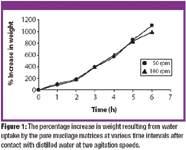
Figure 1
Hydration capacities and erosion. Figure 1 shows the percentage increase in the weight of the hydrated pure gum matrices at various time intervals up to 6 h. There is a strong degree of water uptake by the mucilage powder (≈ 1107% weight increase after 6 h. It is noteworthy, however, that there is little difference in water uptake of the mucilage powder at different agitation speeds (< 10% weight difference at 100 and 50 rpm after 6 h). Hydration is independent of agitation. The large increase in weight resulted from the very strong hydration capacity of the mucilage powder, coupled with very little simultaneous weight loss because of erosion. Erosion was greatly influenced by the agitation speed. Figure 2 shows that only 54% of the mucilage material remained after 6 h at 50 rpm, whereas after the same time period at 100 rpm, the amount remaining was ≈ 74%. Erosion occurred readily from compressed mucilage matrices that were highly influenced by agitation speed. The weight difference with time was clearly a measure of both the hydration and erosion processes occurring simultaneously.

Figure 2
Drug and mucilage mixture. Mucilage matrices contained diclofenac sodium of the optimized batch (HL6) in proportions of 1:2 of the drug to mucilage, respectively. Figure 3 shows the percentage increase in weight resulting from water uptake in distilled water at various agitation speeds. No significant differences in weight gain (i.e., water uptake) between matrices containing the drug at the two different agitation speeds were observed. The only significant differences in weight gain were shown for matrices containing different proportions of mucilage. Matrices containing a lower proportion of mucilage (1:1) showed a lower degree of weight gain with time. This result is expected because the lower proportion of mucilage would decrease the ability of the matrix to absorb water. The dynamic balance between weight gain resulting from water uptake and weight loss resulting from mucilage erosion and drug dissolution was further illustrated by the profiles for mucilage matrices containing diclofenac sodium at both agitation speeds. Figure 4 shows the percentage of erosion into distilled water at two agitation speeds. An initial rapid uptake of water by the dry matrices occurred during the first 2 h, followed by a leveling off of the wet weights because of the increasing rate of erosional release at 100 rpm. This condition persists until the rate of erosion exceeded the rate of water uptake, with a resultant decrease in weight with time.
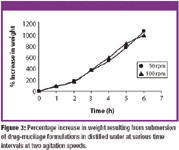
Figure 3
Table VI shows the results of the radial and axial study. The data show that the increase in diameter and thickness was proportionate with time. More swelling, however, occurred in the axial direction compared with the radial direction.

Figure 4
To study the effect of storage on in vitro drug release, a stability study of the best formulation (HL6) was carried out at 40 °C and 75% relative humidity in a humidity oven. Samples were withdrawn after a three-month interval and in vitro drug release was carried out. No change in the in vitro drug release pattern occurred. The value of the similarity factor was 82.14, which indicated a good similarity of dissolution profile before and after stability studies. The calculated t-value (0.997) was smaller than the tabulated value (2.577), which indicated an insignificant difference in the dissolution profile before and after the stability study.
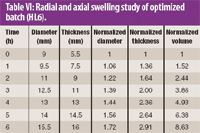
Table VI: Radial and axial swelling study of optimized batch (HL6).
Conclusion
The authors conclude that a novel hydrophilic excipient, such as mucilage extracted from Hibiscus rosa-sinensis Linn, can be used for the development of sustained-release tablets. The dried mucilage powder shows superior swelling capacity and is pH independent. The mucilage can be further explored as a disintegrating agent, gelling agent and modified-release dosage form.
Girish K. Jani, PhD,* is a principal at K.B. Raval College of Pharmacy at Sheratha Post Kasturinagar, Gandhinagar, Gujarat, India 382423, tel.+ 91 793 252 9996, fax +91 792 928 9767, girishkjani2002@yahoo.com Dhiren P. Shah is an assistant professor at C.K. Pithawala Institute of Pharmaceutical Science and Research, Surat, India.
* To whom correspondence should be addressed.
Submitted: Apr. 6, 2007. Accepted May 24, 2007.
References
1. A. Boza et al., "Evaluation of Eudrajit RS-PO and Ethocel 100 Matrices for Controlled Released of Lobenzarit Disodium," Drug Dev. Ind. Pharm. 25 (2), 229–233 (1999).
2. S.A. Bravo, M.C. Lamas, and C.J. Salomon, "Swellable Matrices for the Controlled Release of Diclofenac Dodium: Formulation and In-vitro Studies, " Pharm. Dev. Technol. 9 (1), 75–83 (2004).
3. G.M. Khan and Z. Jiabi, "Formulation and In-vitro Evaluation of Ibuprofen-Carbopol 974P-NF Controlled Release Matrix Tablets III: Influence of Co-Excipients on Release Rate of the Drug." J. Controlled Release 54 (2), 185–190 (1998).
4. L. Genc, H. Bilac, and E. Guler, "Studies on Controlled Release Dimenhydrinate from Matrix Tablet Formulations," Pharm. Acta Helv. 74 (1), 43–49 (1999).
5. G.T. Kulkarni et al., "Evaluation of Binding Properties of Plantago ovata and Trigonella foenum graecum Mucilage," Indian Drugs 39 (8), 422–425 (2002).
6. B. Anroop et al.,"Studies on Ocimum gratissimum Seed Mucilage: Evaluation of Suspending Properties," Indian J. Pharm. Sci. 67 (2), 206–209 (2005).
7. P.D. Bharadia et al., "A Preliminary Investigation on Sesbania Gum as a Pharmaceutical Excipient," Int. J. Pharm. Excipients 1(4), 102–105 (2004).
8. H. Pawar, and P.M. D'mello, "Isolation of Seed Gum from Cassia Tora and Preliminary Studies of its Application as a Binder for Tablets," Indian Drugs 41 (8), 465–468 (2004).
9. D. Thomas and R. Fassihi, "Guar Based Monolithic Matrix Systems: Effect of Ionizable and Non-ionizable Substances and Excipients on Gel Dynamics and Release Kinetics," J. Controlled Release 80 (1–3), 45–56 (2003).
10. M.C. Gohel and K.V. Patel, "Formulation Optimization of Dilitazem-HCl Matrix Tablets Containing Modified Ispaghula Husk using Factorial Design," Drug Dev. Ind. Pharm. 23 (11), 1055–1061 (1997).
11. K.P. R. Chowdary, P. Mohapatra, and M.N. Murali Krishna, "Evaluation of Olibanum and its Resin as Rate Controlling Matrix for Controlled Release of Diclofenac," Indian J. Pharm. Sci. 68 (4), 497–500 (2006).
12. J. Mulhbacher, P. Ispas-Szabo, and M.A. Mateeseu, "Cross-linked High Amylase Starch Derivatives for Drug Release II. Swelling Properties and Mechanistic Study," Int. J. Pharm. 278 (2), 231–238 (2004).
13. R.J. Beveridge et al., "Some Structural Features of the Mucilage from the Bark of Ulmus fulva (Slippery Elm Mucilage)," Carbohydrate Res. 9 (4), 429–439 (1969).
14. S. Nurjaya and T.W. Wong, "Effects of Microwave on Drug Release Properties of Matrices of Pectin," Carbohydrate Polym. 62 (3), 245–257 (2005).
15. P. Santiago et al. "Design of Peumus boldus Tablets by Direct Compression Using a Novel Dry Plant Extract," Int. J. Pharm. 233 (1–2), 191–198 (2002).
16. C.W. Vendruscolo et al, "Xanthan and Galactomannan (from M. scabrella) Matrix Tablets for Oral Controlled Delivery of Theophylline," Int. J. Pharm. 296 (1–2), 1–11 (2005).
17. F. Ughini et al., "Evaluation of Xanthan and Highly Substituted Galactomannan from M. scabrella as a Sustained Release Matrix," Int. J. Pharm. 271 (1–2), 197–205 (2004).
18. U. Melike and A. Turan, "Evaluation of Honey Locust (Gleditsia triacanthos Linn) Gum as a Sustaining Material in Tablet Dosage Form," IL Farmaco 59 (7), 567–573 (2004).
19. P.D. Bharadia et al., "A Preliminary Investigation on Sesbania Gum as a Pharmaceutical Excipient," Int. J. Pharma. Excip. 1 (4) 99–102 (2004).
20. S.K. Baveja, K.V. Rao, and J. Arora, "Examination of Natural Gums and Mucilage as Sustaining Agents in Tablet Dosage Forms," Indian J. Pharm. Sci. 50 (2), 89–92 (1988).
21. S. Sumathi and A.R. Ray, "Release Behavior of Drugs from Tamarind Seed Polysaccharide Tablets," J. Pharm. Sci. 5 (1), 12–18 (2002).
22. D.M. Morkhade et al., "Gum Copal and Gum Damar: Novel Matrix Forming Material for Sustained Drug Delivery," Ind. J. Pharm. Sci. 68 (1), 53–58 (2006).
23. J. Anjaria, M. Parabia, and S. Dwivedi, Ethnovet Heritage–Indian Ethnoveterinary Medicine an Overview. (Pathik Enterprise, Ahmedabad, India, 1st ed., 2002), p. 382.
24. I.A. Ross, Medicinal Plants of the World—Chemical Constituents, Traditional and Modern Medicine Uses (Humana Press, Totowa, NJ 1999), pp. 155-163.
25. K.R. Kirtikar and B. D. Basu, Indian Medicinal Plants (International Book Distributors, Dehradun, India, 1999), p. 335.
26. The Wealth of India, First Supplement Series(Raw Materials) (National Institute of Science and Communication, CSIR, New Delhi, India, Volume 3: D–I, 2002), pp. 386–387.
27. The Wealth of India, First Supplement Series(Raw Materials) (National Institute of Science and Communication, CSIR, New Delhi, India, Volume V: H–K, 2002), pp. 91–92.
28. J.A. Duke, and E. S. Ayensu, Medicinal Plants of China. (Reference Publication Inc., Algonac, MI 1985).
29. J.G. Hardman and L.E. Limbrid. Goodman's and Gilman's The Pharmacological Basis of Therapeutics (McGraw Hill, New York, 9th ed., 1995).
30. P.D. Fowler et al., "Plasma and Synovial Fluid Concentration of Diclofenac Sodium and its Major Hydroxylated Metabolites During Long-term Treatment of Rheumatoid Arthritis," Eur. J. Clin. Pharmacol. 25 (3), 389–394 (1983).
31. J.V. Willis, M.J. Kendall, and D.B. Jack, "The Influence of Food on the Absorption of Diclofenac After Single and Multiple Oral Doses," Eur. J. Clin. Pharmacol. 19 (1), 33–37 (1981).
32. S.P. Wahi et al. "Studies on Suspending Property of Mucilage of Hygrophila Spinosa T. Anders and Hibiscus Esculentus Linn," Indian Drug. 22 (9), 500–502 (1985).
33. F.E. Bowen and W.A. Vadino, "A Simple Method for Differentiating Starches," Drug Dev. Ind. Pharm. 10, 505–511 (1984).
34. L. Lachman, H.A. Libermann, and J.L. Kanig, The Theory and Practice of Industrial Pharmacy (Varghese Publishing House, Bombay, India, 3d ed., 1987), p. 318.
35. D. Thomas and F. Reza, "Guar Based Monolithic Matrix Systems: Effect of Ionizable and Non-ionizable Substances and Excipients on Gel Dynamics and Release Kinetics," J. Controlled Release 80 (1–3), 45–56 (2002).
36. P. Colombo et al., "Drug Release Modulation by Physical Restriction of Matrix Swelling," Int. J. Pharm. 63 (1), 43–48 (1990).
37. M. Bamba and F. Puisieux, "Release Mechanisms in Gel Forming Sustained Release Preparations" Int. J. Pharm. 2, 307-315 (1979).

Drug Solutions Podcast: Applying Appropriate Analytics to Drug Development
March 26th 2024In this episode of the Drug Solutions Podcast, Jan Bekker, Vice President of Business Development, Commercial and Technical Operations at BioCina, discusses the latest analytical tools and their applications in the drug development market.
Full Tolerance Coverage Method for Assessing Uniformity of Dosage Units with Large Sample Sizes
March 10th 2025The ‘full tolerance coverage method’ is introduced as a coverage estimation approach for assessing the uniformity of dosage units from large sample sizes, ensuring that no dosage unit exceeds the specification range.